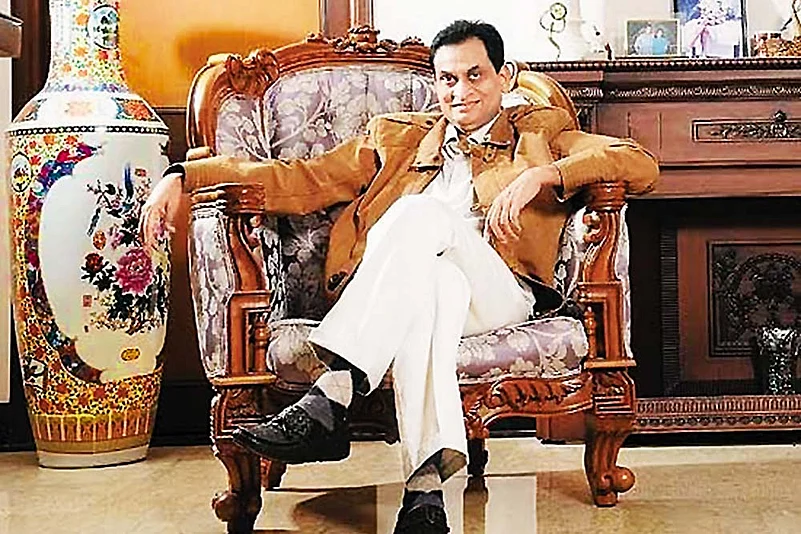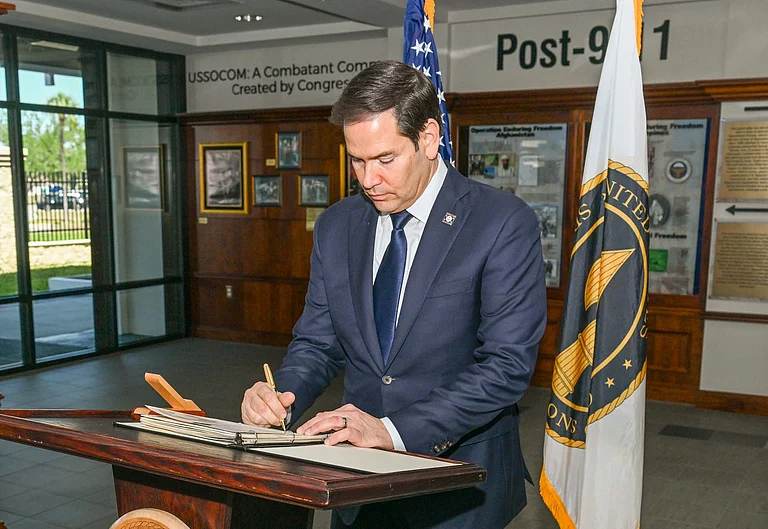For someone who left his home in small-town Cuddalore with just Rs 15,000 in his pocket and today presides over an FMCG empire with a Rs 1,600 crore turnover, C.K. Ranganathan refuses to be overawed by money. For him money is only an enabler that can give jobs to more people, educate the next generation or fund his favourite CSR activities for the physically challenged.
Ranganathan’s CavinKare is the largest FMCG company based out of south India and it pioneered the sachet revolution through its Chik shampoo in 1990. After more than three decades, it flaunts an array of personal care brands, dairy products, beverages, snacks, pickles and even two salon chains—Limelite and Green Trends. The diversification is an outcome of Ranganathan’s intuitive sense to grab any business opportunity. It also reflects the new-found confidence that a liberalised economy infused into budding entrepreneurs like him back then.
The 1991 liberalisation increased the self-confidence of Indian industry like no other event, says CKR, as he is referred to by friends and fellow industrialists. “Indian companies proved that they can compete against international biggies. We may not be among the best of countries for ease of doing business, but things are improving. GST has been a milestone and now that tax laws are simplified things are cleaner,” he says, looking back at his company’s journey from the pre-liberalisation era.

C.K. Ranganathan, founder-chairman of CavinKare
True, the resultant valuation race and stock market pressures compelled companies to become over-reliant on market capitalisation. But for CKR success in business is not just about market capitalisation. “Unless wealth generated from the business is used to benefit all stakeholders—employees, retailers and customers—it ceases to have any meaning. We must not forget that every business is an entity in society and has to be beneficial to society. You take money and you are giving it back. For me, keeping all stakeholders, including customers, happy is more important than market cap. And if they are happy your market cap will also look up,” says CKR, explaining his business mantra.
It is pertinent to note that he doesn’t mention shareholders among the stakeholders. This is because the company is owned by the family, and isn’t listed on the stock exchanges. Hence, there are no pressures on CKR to show quarterly financial performances, and keep an eye on the ever-fluctuating stock prices, which occasionally move up and down for no ostensible reason. Other owners and founders are not so lucky. For many, valuations come first, especially when the worth of the stocks enables promoters to raise money to fund expansions and diversifications.
There is another little-discussed aspect of stock valuations. Unlike in the past, when the rich were defined by the assets they owned, such as cash, bank deposits, gold and jewellery, real estate and cars and planes, things changed as India transited from the socialist era to a market-oriented one. Suddenly, wealth became more transparent, as in those who had it were prone to show it rather than hide it. Although the practices continued, no longer were the rich compelled to own assets in complex, benami ways. At the same time, wealth became ephemeral; a transient quality crept into it.

Globally, as well as in India, net worth of the super-rich was assessed largely by the values of the stocks they owned, mostly in their companies, and the prices of the assets that they possessed and declared openly. Thus, stock prices became the key differentiator between the old aristocratic moneyed-class, and the neo-rich. Individuals became dollar-billionaires within months and years, as their companies were listed on stock exchanges at unimaginable prices, while other firms shed their exalted status within no time. Wealth fluctuated on a minute-by-minute basis.
To give an example, 66,000 Indians lost their dollar-millionaire status during the pandemic. This happened as some of the richest billionaires like Mukesh Ambani and Gautam Adani increased their wealth during the same period. What’s pertinent is that stock volatility this year implied that net worth of several billionaires was eroded by a few billion dollars within a few days. In a few trading sessions in June this year, Adani’s individual riches were wiped out by more than $20 billion. However, with a wealth of over $60 billion on June 30, he was the 19th richest person on the planet.
Hence, for those in the top one per cent of the economic class, money influences their lives like never before. They are obsessed with it, more so with being the richest or among the top 10 or 20. They do everything to shore up stock prices, by every imaginable means. But they are others who, after being fabulously rich, did not care about money. It is this that gels with CKR’s overall philosophy towards money and wealth. “Money doesn’t influence me. The impact I make on society and the number of people who benefit from that matters more to me. I am meaningfully employed and being beneficial to society. My colleagues and I are able to create more jobs. I think I inherited my father’s detached attitude towards wealth,” is how he puts it.
Again, for someone whose success has been entirely of his own making, CKR also does not flaunt his wealth. In this, he remains a chip off the old block—his late father Chinni Krishnan had observed, while introducing shampoos in sachets: “What the rich man can enjoy, the poor man should be able to afford”. He admits that unlike in the past the display of wealth in India in the last two decades has become more prevalent, an industry by itself. “Mindset wise, displaying wealth is not a wrong thing. The successful want to know and show what is their worth. They go public in encashing and enjoying its fruits. For them displaying wealth is no longer taboo. But the South is still lagging behind,” he points out.
It is not that the high net-worth individuals did not spend ostentatiously in the past. Before the 1990s (possibly the ’80s), they were guarded because they had to hide their incomes due to obscenely prohibitive taxes. During the 1970s, the highest personal income tax rate was an “astronomical” 97.5 per cent. In effect, if people displayed their expenditures, the taxmen would come calling and ask them for details of their earnings. Today, as rates are more manageable, many companies are listed, hence their accounts are transparent and thus businesspersons have no qualms in show their wealth.
In fact, there is a public relation industry that thrives on advertising what the rich and famous buy on a regular basis. Their purchases of Tesla and Ferrari are meant for public consumption. The same is true if someone buys a palace or two in Europe. Indian weddings, especially in rich families, have only become bigger and fatter over the years. At a recent wedding in a well-known business family, each wedding card, laden with gold, was estimated to cost Rs 1,00,000. Now, it is common for spouses to gift aircraft and sailboats to their partners, and then issue press releases on them.
Ranganathan’s sprawling farmhouse on Chennai’s East Coast Road with its aviaries of exotic birds is his favourite retreat and is probably his most prized acquisition. He spends a considerable time among the cockatoos, pheasants, macaws, parakeets, lorikeets and rheas, describing it as an energising experience. It is part of his Invest In Yourself (IIY) programme, in which he devotes nearly three hours every morning to upgrade himself by visualisation, thinking, reading and planning for the day. He extended this to his company, where 40 per cent of the employees use the first hour, 9.30 am to 10.30 am, for upgradation. “They read or listen or watch videos of subjects in alignment with the supervisor. Every Friday they make a presentation on how it can help the company. This experiment has gone exceedingly well, which helps us to adapt to changes around us—social, media, environment etc,” CKR explains his formula to handle change.

Another major activity for this unassuming business head is his involvement with The Ability Foundation, an NGO which he co-founded, to tap the potential amongst the physically challenged, mentor them to develop a successful business as well as honouring them with the CavinKare Ability Awards. Another pet project is the CK School of Practical Knowledge where vocational and value-based courses are taught to school kids. “For example, other than regular factory visits, students are taken to single owner business establishments like grocery stores and tea shops to learn how grassroots business functions. It gives them the confidence to set up their own business, however small it may be,” he points out.
For CKR, who is only 60 years old, identifying a successor may not be at the top of his agenda, but he has gone about it in a different way in grooming his three children—daughters Amutha and Dharani and son Manu—to play an active role in running CavinKare. He gave them seed money to start and run their own businesses, and now all three are doing well,” he discloses. “Most importantly, they should not feel that stepping into CavinKare was some kind of entitlement. I am a firm believer in meritocracy and it should start with my family,” he adds.
The transfer of wealth within a business family, or the manner in which it flows from the patriarch to the growing members over the next few generations has changed over the past seven decades. In the past, most patriarchs and matriarchs were unwilling to anoint their successors, or distribute their companies among children, during their lifetimes. This led to bitter and public spats over succession. During the 1980s, two of the most vehement battles were among the Birla and Modi clans. In the latter, the several competing cousins destroyed the business empire.
By the 1990s, when the waves of globalisation hit Indian shores, some business owners wished to disassociate ownership from management. They decided that their children would own the wealth, but not the operation of the companies. They hired professional managers for the job, as was the case in the West. The experiments failed, as the second and third generations clawed back to take their due places in the corner rooms. There was also a talk of meritocracy, which too did not take off. After all, which sibling would publicly agree that he or she was a black sheep?
It therefore became imperative for ailing owners to leave behind wills (which too were legally contested), and resort to concrete succession planning. This involved putting different children as independent heads of different companies and operations so that segregation of powers, responsibilities and wealth was easier. It was not a foolproof system, but was better than not having a plan in place. One needs to see how CKR’s merit-oriented succession will fare in the future. Several business historians comment that the life of a business empire is 60 years, over three generations. But many families have proved this dictum wrong.
As for mentoring his children, CKR is just watchful of statutory violations. “They are free to bounce ideas if they feel like it. Sometimes they do but ultimately the decision is theirs. In the process, I also learn from them as I know if their decisions worked or not. This helped them learn to handle money, people, understand statutory formalities, quality assurance, meeting stakeholder expectations,” Ranganathan points out. After demonstrating their business acumen, his son Manu heads the retail arm, while daughter Amutha handles e-commerce at CavinKare. The other daughter, Dharani, is into home baking and wants to expand it in a big way. One day they will preside over the empire that their father had so lovingly and assiduously built from Rs 15,000.
***

Liberate the purse-strings
How liberalisation created opportunities, funding and wealth
Chandu Nair
Till the 1990s, it was a lot tougher to be an entrepreneur, get equity fundin g, fail and yet be supported and to get second chances. Then, there was a Dil Chahta Hai (a movie released in 2001) moment circa the beginning of this millennium. Like in the hit movie’s male and female protagonists, the aspirations of a new liberalised India and its people meant that it was okay to have money and enjoy it as well. Equally, it became apparent that in order to progress, one had to go global and reduce one’s dependence on the state and governments. Funding options increased, opportunities for first-generation entrepreneurs multiplied, and new areas emerged where traditional, family businesses generally feared to tread. My partners and I too morphed both personally and professionally during the dotcom era. We managed to find new niches in the knowledge services space. We were funded and this helped us take full advantage of emerging opportunities and scale up our business substantially. In less than a decade, not only did we manage to give our venture capitalist an 8 X exit (return of eight times the initial investment), we also snagged a strategic investor who eventually bought us out 100 per cent. As first generation entrepreneurs, we didn’t do too badly in the area of wealth creation.
(This appeared in the print edition as "Plumage In Muted Colours")
(A former start-up founder, Chandu Nair is a consultant and an angel investor)
ALSO READ
By G.C. Shekhar in Chennai


























